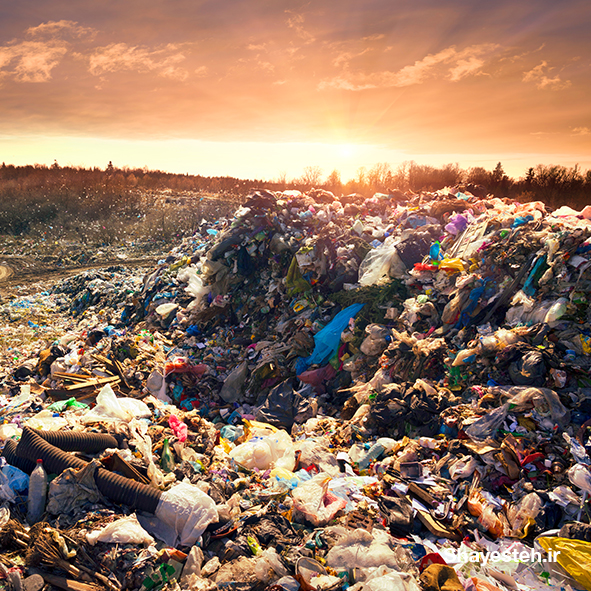در صورتی که اشکالی در ترجمه می بینید می توانید از طریق شماره زیر در واتساپ نظرات خود را برای ما بفرستید
09331464034
Topic:
The following appeared in a memorandum written by the chairperson of the West Egg Town Council.
"Two years ago, consultants predicted that West Egg's landfill, which is used for garbage disposal, would be completely filled within five years. During the past two years, however, the town's residents have been recycling twice as much material as they did in previous years. Next month the amount of recycled material — which includes paper, plastic, and metal — should further increase, since charges for pickup of other household garbage will double. Furthermore, over 90 percent of the respondents to a recent survey said that they would do more recycling in the future. Because of our town's strong commitment to recycling, the available space in our landfill should last for considerably longer than predicted."
Write a response in which you discuss what specific evidence is needed to evaluate the argument and explain how the evidence would weaken or strengthen the argument.
موارد زیر در یک یادداشت نوشته شده توسط رئیس شورای شهر West Egg نشان داده شده است.
"دو سال پیش، مشاوران پیش بینی كردند كه دفن زباله West Egg كه برای دفع زباله استفاده می شود، طی 5 سال كاملاً پر شود. با این وجود طی دو سال گذشته، ساكنان شهر دو برابر بیشتر از گذشته بازیافت كرده اند. ماه آینده میزان مواد بازیافتی - که شامل کاغذ، پلاستیک و فلز است - باید افزایش یابد، زیرا هزینه های حمل سایر زباله های خانگی دو برابر می شود. علاوه بر این، بیش از 90 درصد پاسخ دهندگان به نظرسنجی اخیر گفته اند که در آینده بازیافت بیشتری انجام خواهند داد. به دلیل تعهد شدید شهر ما در مورد بازیافت، فضای موجود در محل دفن زباله ما باید برای مدت زمان طولانی تری از آنچه پیش بینی شده است ادامه یابد.
پاسخی بنویسید و در آن توضیح دهید که چه مستندات خاصی برای ارزیابی بحث لازم است و شرح دهید که چگونه این مستندات می تواند بحث را تضعیف یا تقویت کند.
Strategies
The first step in performing your analysis consists of identifying the texts’ key point, recommendation, prediction or hypothesis. All the other arguments and assumptions are designed to support this central claim. In this case, the author attempts to demonstrate that “West Egg’s landfill should last longer than predicted”.
The next step would involve creating a statement that summarizes the text by including the central claim and its supporting arguments.
The West Egg Town Council chairperson predicts that due to a significant increase in material recycling the town’s landfill space should last longer than the 5 years that were estimated by experts.
When considering the evidence that is necessary to support the arguments outlined in the text, it is important to keep in mind that arguments are based on assumptions – points that are taken to be true, without need for proof. This is what you need to look for – explicit and implicit assumptions, since they require evidence that is not already listed in the text.
Assumptions:
i) Explicit Assumption: Increased recycling means significantly less material is sent to the landfill
Implicit Assumption
a) Recycled material constitutes a great percentage of the monthly waste production per household
ii) Explicit Assumption: Increased recycling means significantly less material is sent to the landfill
Implicit Assumption
a) Recycled material constitutes a great percentage of the monthly waste production per household
ii) Explicit Assumption: Increased household garbage pickup fees will stimulate recycling
Implicit Assumption
a) Recycling can be greatly increased
iii) Explicit Assumption: Residents declared pro-recycling attitude will translate into facts
Implicit Assumption
a) Household waste production rates will not change
iv) Explicit Assumption: Filling rate of the West Eng landfill has dropped
Implicit Assumptions
a) Stable population growth
b) Reduction in ‘other household garbage’ collection means less trash will go to the landfill
c) Garbage pickup fees are an effective measure
d) The survey respondents are representative for the population
e) West Egg landfill is currently emptier than predicted
Evidence:
a) Percentage of material currently being recycled out of monthly waste production rates
b) Percentage of non-recyclable material out of the monthly waste production
c) Comparison of the amount of waste that can be recycled with the amount of waste that is recycled
d) Waste production rates over the years compared with recycling rates
e) Population expansion rates compared to recycling rates
f) Percentage of improperly sorted material that is non-recyclable and will end up in the landfill
g) Survey on primary motivations for recycling
h) Percentage of survey respondents out of the total city population
i) Survey demographics compared to the town’s demographics
j) Current infrastructure waste handling capacity reported to the expected increase in recycling
k) Current assessment of how full the landfill is compared to the predicted assessment
Sample 1:
The West Egg Town Council chairperson predicts that due to a significant increase in material recycling the town’s landfill space should last longer than the 5 years that were estimated by experts. To accurately assess the prediction, the town council would require data about the current landfill occupation levels. This information will serve to prove or disprove if the filling rate matches the councilperson’s predictions. Should the fill rate prove to be slower than the expert’s estimation, then the chairperson’s assessment of the future of West Egg’s landfill would be undermined, although, this evidence would have no definitive bearing on whether recycling is responsible for the positive results. Having the data reveal the opposite, that the landfill’s occupancy rate matches or exceeds the expert’s evaluation, would cast doubt on the effectiveness of recycling and the optimistic outcome envisioned by the chairperson. In this case, alternative measures would have to be taken to ensure that the occupancy rate of the town’s landfill decreases to more manageable levels.
West Egg’s chairperson invokes other arguments when making his prediction, chief among them being the fact that an increase in recycling would mean that significantly less waste material is sent to the landfill. The chairperson rests this argument on the assumption that recycled material constitutes a great percentage of the monthly waste production per household. As such, to validate the claim, the author would have to provide evidence related to the percentage of material currently being recycled out of monthly waste production rates. This evidence can showcase whether the amount of material being recycled is sufficient to prompt a drop in the landfill rates, or whether the total amount of recycled material is low enough not to warrant such optimistic forecasts about the future of the town’s landfill – a doubling of a low percentage would still constitute a low percentage. When discussing the increase of recycling and its effects on the town, the chairperson would have to research alternative measures of waste management to be able to meet the prediction about the landfill rate.
Another assumption made by the chairman in his prediction is centered on the idea that some of the parameters of the equation will remain unchanged, namely the fact that household waste production rates do not change, and the population size is stable. If population expansion rates were to reveal a drastic increase in the number of residents in West Egg, then the amount of waste material produced would also increase. The author of the prediction would have to consider this new data and factor it in against recycling rates to determine whether the filling rate has remained constant or if recycling needs to be increased even more to deal with the surplus of waste material. However, if the data were to reveal that the population is stable or decreasing, then the chairman’s predictions would not be affected by the outcome. The relative stability of waste production rates also comes into play when assessing the future effects of recycling. A stable monthly waste production rate would mean that any increase in recycling would reduce the amount of material being sent to the landfill. However, if people were to produce more waste each month, then an increase in recycling might end up evening out with the surplus of material and not having any effect on the amount of garbage being sent to the landfill. The chairman should support his prediction with more data about the makeup of the monthly household waste rates and population information if he wants to make a more accurate estimate of the future landfill occupancy.
The chairman cites survey findings as a basis for predicting an increase in recycling rates in West Egg. When handling surveys and statistic data it is always important to look not only at the results but also at the theoretical framework and methodology of the study being conducted, to be able to ascertain whether the reasoning is sound, or if the scientists have missed some crucial aspect or mitigating factor. The chairman needs to take into consideration how comparable are the demographics of the survey participants to those of the general population of West Egg. If the general population is not accurately represented by the survey respondents, then it would become more difficult to support the claim that recycling will increase in the future. However, if the beliefs of the town’s residents are accurately reflected by the cited survey, then it becomes more likely that the predicted increase in recycling will match the expected rates.
All in all, the chairperson needs to take a lot more evidence into consideration to ensure that the landfill predictions have a solid factual basis. The author should also take measures to ensure that the increase in recycling can be easily supported by the infrastructure.
Sample 2:
The mayor of the town West Egg asserts that the space available in West Egg’s landfill for garbage disposal would last for a time period longer than the five years that were predicted two years ago. He provides three assumptions in support of the assertion made by him. Firstly, the recycling of aluminum and paper by the town residents has doubled in the past two years. Secondly, the amount of material to be recycled will presumably increase as the charges for garbage pickup will double up from the coming month. Lastly, as per the results of a recent survey, more than ninety percent of the participants claimed that they will be increasing their recycling efforts in the future. Despite the assumptions made in its support, the argument fails to convince the reader that the assertion made is well balanced and reasonable.
It is not necessary that aluminum and paper are the only waste materials that will be dumped at the landfill. The argument makes no mention of the other types of waste materials like plastic and rubber. If these types of waste materials are not being recycled, then they are bound to be dumped at West Egg’s landfill and they will obviously contribute to the filling up of the available space. Therefore, the contention that the increase in recycling of aluminum and paper will make a huge difference to the filling up of the landfill cannot be considered as reasonable.
The arguer makes the assumption that the increase in the charges for garbage pickups will lead to an increase in the amount of waste materials being recycled by the residents. However, the arguer fails to provide adequate proof that can prove beyond doubt that a majority of the residents of West Egg will resort to recycling garbage by themselves in order to avoid paying higher charges for garbage pickups. Additionally, the arguer has not addressed the issue wherein the residents would have to find some way of disposing waste materials that cannot be recycled. In such a case, they will be forced to avail the facility of garbage pickup and hence, they may lose interest in attempting to recycle some of the garbage themselves as they would already be paying to get the remaining garbage disposed. Therefore, this assumption fails to support the assertion that an increase in the garbage pickup rates would lead to a greater amount of garbage being recycled by the residents themselves.
The evidence provided by the arguer in the form of the results of a recent survey does not stand on firm ground as there is no mention of the statistics related to the ninety percent of people who are keen on recycling garbage in the future. There is no indication of the proportion of people among these ninety percent who are already recycling waste materials. If a majority of these ninety percent people are already recycling garbage, then their committing to recycle garbage in the future would make no major difference to the rate at which the available space at the landfill would get filled as compared to what had been calculated two years ago. Moreover, with the passage of time, there is bound to be an increase in the town’s population and the additional people will add waste materials to the garbage being dumped at the landfill. The perspective of these people has not been included in the survey and therefore, the results of the survey do not hold good for predicting that the available space at the landfill will last for longer than five years.
Therefore, no evidence provided by the arguer supports the assertion made in the argument. The argument could have been substantiated better if the arguer had provided tangible evidence to prove that there will be a significant increase in the amount of waste materials being recycled and this would make a huge difference to the depletion of the available space at West Egg’s landfill resulting in its lasting for more than the predicted five years.
نظرات کاربران
هنوز نظری درج نشده است!


